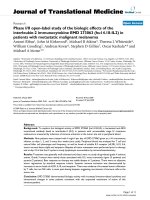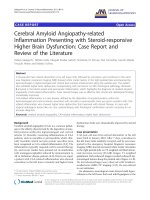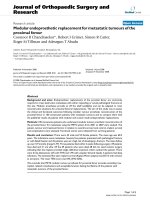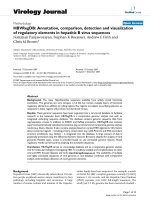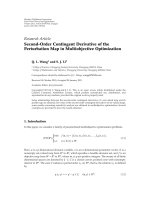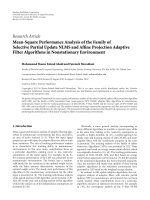báo cáo hóa học:" Posterior cruciate ligament mediated avulsion fracture of the lateral tibial condyle: a case report" potx
Bạn đang xem bản rút gọn của tài liệu. Xem và tải ngay bản đầy đủ của tài liệu tại đây (1.65 MB, 6 trang )
CAS E REP O R T Open Access
Posterior cruciate ligament mediated avulsion
fracture of the lateral tibial condyle:
a case report
Hiroyasu Ogawa
1*
, Hiroshi Sumi
2
, Katsuji Shimizu
1
Abstract
Avulsion fractures of the posterior cruciate ligament (PCL) are uncommon. On the basis of the site of damage of
the PCL, hyperflexion, pretibial trauma, and hyperextension are proposed as mechanisms of PCL injuries. On the
other hand, avulsion fractures of the tibial condyle are also rare. We report a PCL-mediated avulsion fracture of the
lateral tibial condyle along with the tibial insertion of the PCL by extension-distraction force on the knee that has
not been previously described in any study. This rare case may imply that application of an extension-distraction
force to the PCL cause the avulsion fracture.
Background
Avulsion fractures of the posterior cruciate ligament
(PCL) are uncommon. A few mechanisms of PCL inju-
ries have been proposed on the basis o f the site of
damage of the PCL [1]. The most common mechanism
of avulsion fractures of the PCL at the tibial insertion is
a dashboard injury, in which the knee is in a flexed posi-
tion, and a posteriorly directed force is applied to the
pretibial area [1]. Avulsion fractures of the tibial condyle
are also rare [2,3]. The most common subset of avulsion
fractures of the lateral tibial condyle is the Segond frac-
ture. It is a small avulsion fracture of the proximal
lateral tibial condyle that is induced by a force applied
on the lateral capsule a nd the associated meniscotibial
ligament [3]. Herein, we report a PCL-mediated avulsion
fracture of the lateral tibial condyle along with the tibial
insertion of the PCL by a mechanism that, to the best of
our knowledge, has not been previously described in any
study. Our patient and his family were informed that the
data obtained in this cas e would be submitted for publi-
cation, and they consented to its publication.
Case presentation
A 33-year-old male forestry worker sustained an injury
to his right knee. While he was climbing a steep hill, a
rolling log hit the anterior aspect of the extended knee
at the level of the tibial tubercle with a posteroinferiorly
directed force. At this time, his right lower leg was
pulled down and extended forcibly by the rolling l og,
and he experienced immediate pain, swelling of the
knee, and inability to bear weight on the right leg. The
patient was transferred to our hospital for examination.
On clinical examination, we found that he had si gnifi-
cant effusion in the affected knee. He complained of
pain in the knee, especially during active and passive
extension of the knee. There was tenderness at the pos-
terior aspect of the knee, and no deficit was found in
the neurovascular system. The knee was stable under
varus and valgus stress, and the result of the anterior
drawer test at 90° of knee flexion was negative. Posterior
tibial sag was apparent, and the posterior drawer test
with the knee flexed at 90° revealed a grade III instabil-
ity (approximately 12 mm of posterior translation) with
a soft endpo int. Radiographs revealed fractures of the
posterior intercondylar eminence and the lateral tibial
condyle (Fig. 1). The positions and sizes of the displaced
fracture fragments were verified using computed tomo-
graphy (CT) (Figs. 2 and 3). Magnetic resonance ima-
ging (MRI) of the knee revealed that the anterior
cruciate ligament (ACL), collateral ligaments, and both
meniscuses were intact. The appearance of the posterior
cruciate ligament (PCL) was consistent with that of a
PCL avulsion fracture at the tibial insertion, and the
* Correspondence:
1
Department of Orthopaedic Surgery Gifu University, Graduate School of
Medicine, 1-1, Yanagido, Gifu, Gifu, 501-1194 Japan
Full list of author information is available at the end of the article
Ogawa et al. Journal of Orthopaedic Surgery and Research 2010, 5:67
/>© 2010 Ogawa et al; licensee BioMed Centra l Ltd. This is an Open Access article distributed under the terms of the Creative Commons
Attribution License ( which permits unrestricted use, di stribution, and reproduction in
any medium, provid ed the original work i s properly cited.
lateral tibial condyle was avulsed anterosuperiorly with-
out disruption of the articular cartilage (Fig. 4).
Arthroscopic examination revealed that the ACL, both
meniscuses, collateral ligaments, and popliteal tendon
were intact; the substance of the PCL was loose but not
ruptured, and the cartilage surface of the lateral tibial
condyle was not fractured but undulating. These find-
ings were consistent with the MRI findings. On the
basis of these findings, especially considering the PCL
instability and his activity as a forestry worker, he was
selected as a candidate for surgery.
During the operation, the patient was placed in a prone
position, and a sinusoidal incision was made from the
biceps femoris muscle to the medial head of the gastro-
cnemius muscle, with the transverse limb of the incision
across the knee-flexion crease. The lesser saphenous vein
and the medial sural cutaneous nerve were identified
over the popliteal fascia, and these structures were
Figure 1 Initial anteroposterior and lateral radiographs of the knee, showing fractures of the lateral tibial condyle (a) and the
posterior intercondylar prominence (b).
Figure 2 Computed tomography scans showing sagittal and coronal views of the knee: the displaced fragments of the posterior
intercondylar eminence (a) and the avulsed lateral tibial condyle (b) can be observed.
Ogawa et al. Journal of Orthopaedic Surgery and Research 2010, 5:67
/>Page 2 of 6
protected with a Penrose drain. A longitudinal incision
was made in the fascia along the margin of the medial
sural cutaneous nerve in order to identify the tibial nerve,
the popliteal artery and vein, and medial border of the
medial head of the gastrocnemius. Continuation of the
deep blunt dissection allowed the identification of the
oblique popliteal ligament and the posterior capsule,
which were found to be intact. A vertical incision was
made across the capsule, and both edges of the incision
were elevated. The avulsion fracture at the tibial insertion
of the PCL was i dentified, and the lateral tibial condyle
was also found to be anterosuperiorly avulsed. Neither
meniscosynovial junction injuries nor compression injury
to the lateral tibial condyle were observed. The fragm ent
of the lateral tibial condyle, including the cartilage, was
approximately 10-mm thick, and it formed approximately
40% of the articular surface of the lateral tibial condyle.
These fragments were independent, but they shared a
common bed. Furthermore, the fragment of the lateral
tibia l condyle partially formed the bed of t he fragment of
the tibial insertion of the PCL. After debridement of the
base, the fragment of the lateral tibial condyle was
reduced anatomically and stabilized using a Kirschner
wire. Next, the fragment of the tibial insertion of the PCL
was fitted into the crater, which was framed by the frag-
ment of the lateral tibial condyle and the intercondylar
eminence. After the fragments were stabilized with
Kirschner wires, definitive fixation was achieved using a
3.5-mm cortical screw for the fragment of the tibial inser-
tion of the PCL and a 4.0-mm cancellous screw for the
fragment of the lateral tibial condyle. These screws were
positioned from the posterosuperior to the anteroinferior
side to achieve compression. The capsule, subcutaneous
layers, and skin were subsequently closed. The knee was
kept at 30° flexion in a cast.
After the operation, the patient’slegwasplacedina
hinged knee brace fixed at at 30° flexion, the patient was
permitted to bear partial body weight on the toes on post-
operative day 1. Active flexio n and extension exercise s of
the knee were initiated 2 weeks after the operation. At the
6-month postoperative follow-up examination, the
patient’s leg had regained its preoperative function with a
full range of motion of the knee. Radiographs obtained
6 months after surgery also revealed healed fractures and
no loss of fixation (Fig. 5), and the posterior drawer test
revealed a grade-I instability (approximately 3 mm of pos-
terior translation) with a hard endpoint.
Discussion
This case report describes an unusual PCL-mediated
avulsion fracture of the lateral tibial condyle. This injury
may be different from other reported PCL injuries
Figure 3 Computed tomography scans showing three-
dimensional reconstruction views of the knee: the displaced
fragments of the posterior intercondylar eminence and the
lateral tibial condyle can be observed.
Figure 4 Sagittal and coronal T2-weitghted magnetic resonance images of the knee, showing u pward displacement of the PCL
insertion at the tibia (a) and the displaced fragment of the lateral tibial condyle (b and c).
Ogawa et al. Journal of Orthopaedic Surgery and Research 2010, 5:67
/>Page 3 of 6
because it was caused by a mechanism that has not been
reported previously, to the best of our knowledge.
In this case, a fragment of the lateral tibial condyle
was avulsed anterosuperiorly along with the fragment of
the tibial insertion of the PCL. The fragment of the lat-
eral tibial condyle partially formed the base of the frag-
ment of the tibial insertion of the PCL. These findings,
in particular, the shape and position of the fragm ents,
strongly suggested that the tibial insertion of t he PCL
was isolated from the fragment of the lateral tibial con-
dyle subsequent to the PCL-mediated avulsion fracture
of the lateral tibial condyle. The lack of comminution,
joint depression, capsular injury , and visible cartilage
damage also favored the role of an avulsion mechanism
in the fracture of the lateral tibial condyle. Avulsion
fractures of the posterolateral tibial condyle are rare
because there is no muscle insertion on the posterior
aspect of the lateral tibial condyle. This unusual injury
pattern may be due to the manner in which the injury is
suffered and the anatomy of the PCL, which should b e
investigated to eluc idate the fundamenta l functions of
the PCL.
PCL injuries usually occur at the femoral origin, in the
substance, and at the tibial insertion of the PCL [4].
However, in this case, the main injury site was the lat-
eral tibial condyle. The lateral tibial condyle is rarely
damaged a s a result of PCL injuries, though damage to
the lateral condyle may be broadly categorized as a tibial
insertion site injury. Depending on the site that has
been damaged, 3 possible mechanisms for PCL injuries
have been proposed as follows [1]. (1) Hyperflexion is
commonly observed in individuals involved in sport
activities. In this case, the PCL is guil lotined between
the posterior tibial plateau and the roof of the femoral
notch, resulting in rupture of the midsubstance [5]. (2)
Dashboard injury is a common injury observed in preti-
bial trauma, in which the knee is in a flexed position
and a posteriorly directed force is applied to the preti-
bial area. Th is type of an injury results in a substance
tear at the level of the tibial plateau or a tibial avulsion
fracture [6]. (3) Hyperextension can result in proximal
rupture of the PCL and posterior capsule. PCL injur ies
frequently occur as proximal disruption of the femoral
attachment [7]. However, the mech anism of injury in
this case did not correspond to any of the above
mechanisms from the perspective of the relationship of
themechanismtothesiteofdamage.Thisisbecause
the knee extension that occurred in the case of our
patient was inconsistent with a pretibial trauma, and the
lack of a posterior capsule tear and soft tissue damage
were inconsiste nt with a hyperextension injury. Further-
more, a recent b iomechanical study concerning knee
hyperextension revealed that knee hyperextension
showed a general i njury pa ttern to the posteolateral cor-
ner and no gross posterior cruciate ligament injuries [8],
which may contradict simple hyperextension mechanism
in this case. An in-depth interview of the patient
revealed that the injury might have been caused by
extension-distraction of the knee when the log rolling
down a steep hill hit the extended knee with a poster-
oinferiorly directed force though we could not still
neglect posteriorly directed force on the extended knee
Figure 5 Radiographs (a and b) at the 3-month follow-up showing union of the bone fragments.
Ogawa et al. Journal of Orthopaedic Surgery and Research 2010, 5:67
/>Page 4 of 6
at the level of the tibial tubercle. Subsequently, the
extension-distraction force may have acted on the PCL
only to a slight extent so that the lateral tibial condyle
was avulsed, but the posterior capsule was not injured.
Hyperextension would lengthen a ll structures posterior
to the knee axis, but mechanically, this lengthening
force would be greater more posterior to the knee axis.
Thus, an independent hyperextension force would
lengthen the posterior capsule to a greater extent than
the PCL, w hich would predispose the posterior capsule
to rupture. In contrast, a distraction force would
lengthen all the structures in the knee, and this force
would be greater in tighter and shorter structures,
which may result in lengthening of only the PCL but
not the posterior capsule. Thus, from the mechanical
viewpoint and the radiographic and intraoperative find-
ings, we consider the distraction force to be more domi-
nant than the hyperextension force in this case because
the PCL was injured but not the posterior capsule.
The morphology of the tibial insertion site of the PCL
may be another cause of this specific PCL injury . The
PCL separates into the anterolateral and posteromedial
bundles [4,9]. The substances of these bundles vary in
width. The surface areas of the tibial insertion sites also
vary in size: the largest surface areas are 2 times larger
than the smallest surface areas. However, the shapes
and positions of these insertion sites are consistent in
osseous landmarks. The PCL is attached to the posterior
intercondylar fossa between the tibial plateaus, and it
also extends b elow the posterior part of the tibial rim.
This fossa is trapezoid in shape, and it widens inferiorly.
Peripheral fibers of the PCL are attached extensively to
the distal tibial periosteum [4]. Thus, the PCL can toler-
ateadistractionforcethatisstrongenoughtoavulse
the lateral tibial condyle if the surface area of the tibial
insertion site and the substance of the PCL are signifi-
cantly wider.
With regard to the trea tment, non operative treatmen t
was another choice, but loss of the range of motion of
the knee with some residual PCL laxity can be a signifi-
cant problem in long-term [10]. Furthermore, osteone-
crosis or nonunion of the frag ment of the tibial
insertion of the PCL was another concern because a
part of its base was framed by the fragment of the lat-
eral tibial condyle; this was disadvantageous to blood
supply. However, the open posterior approach allowed
remarkable direct visualization of the fracture sites, and
adequate reduction and fixation of the fragments could
be successfully performed . In our opinion, the posterior
approach was a better alternative than arthroscopic sur-
gery in this case because of the complex fracture pattern
of the tibial insertion of the PCL, which was revealed by
radiographic and intraoperative findings. Preoperative
three-dimensional reconstruction CT and MRI were
performed to dec ide the surgical approach and the
method for fixing the fragments.
PCL injury patterns are complex and are related to
diverse mechanisms of injury and to the structure of the
PCL. The major functions of the PCL are to resist pos-
terior tibial translation, varus and valgus forces applied
to the knee, as well as external rotatio n of the tibia [9].
However, the PCL is not known to resist a distraction
force. This rare case may imply that application of an
extension-distraction f orce to the PCL may cause avul-
sion fracture of the lateral tibial condyle. A biomechani-
cal study is required to verify this function of the PCL
against an extension-distraction force in the knee. This
data obtained in this study and such biomechanical stu-
dies would be of value not only in further understanding
the unique mechanism of PCL injuries but also the basic
function of the PCL, which would help improve the
methods used for reconstruction surgery of the PCL.
Consent
Written informed consent was obtained from the
patients for publication of this case report and the
accompanying images and coupes.
Author details
1
Department of Orthopaedic Surgery Gifu University, Graduate School of
Medicine, 1-1, Yanagido, Gifu, Gifu, 501-1194 Japan.
2
Department of
Orthopaedic Surgery Sumi Memorial Hospital,2-1, Shirotori, Shirotori-cho,
Gujo, Gifu, 501-5121 Japan.
Authors’ contributions
HO performed surgical procedure, designed manuscript, and collected
patient information. HS participated in surgery and follow-up. KS advised on
design of this report. All authors read and approved the final manuscript.
Competing interests
The authors declare that they have no competing interests.
Received: 7 July 2010 Accepted: 8 September 2010
Published: 8 September 2010
References
1. Janousek AT, Jones DG, Clatworthy M, et al: Posterior cruciate ligament
injuries of the knee joint. Sports Med 1999, 6:429-441.
2. Falciglia F, Mastantuoni G, Guzzanti V: Segond fracture with anterior
cruciate ligament tear in an adolescent. J Orthop Traumatol 2008,
3:167-169.
3. Goldman AB, Pavlov H, Rubenstein D: The segond fracture of the
proximal tibia: A small avulsion that reflects major ligamentous damage.
AJR Am J Roentgenol 1988, 6:1163-1167.
4. Tajima G, Nozaki M, Iriuchishima T, et al: Morphology of the tibial insertion
of the posterior cruciate ligament. J Bone Joint Surg [Am] 2009, 4:859-866.
5. Fowler PJ, Messieh SS: Isolated posterior cruciate ligament injuries in
athletes. Am J Sports Med 1987, 6:553-557.
6. Schulz MS, Russe K, Weiler A, et al: Epidemiology of posterior cruciate
ligament injuries. Arch Orthop Trauma Surg 2003, 4:186-191.
7. Kannus P, Bergfeld J, Jarvinen M, et al: Injuries to the posterior cruciate
ligament of the knee. Sports Med 1991, 2:110-131.
8. Fornalski S, McGarry MH, Csintalan RP, et al: Biomechanical and anatomical
assessment after knee hyperextension injury. Am J Sports Med 2008,
1:80-84.
Ogawa et al. Journal of Orthopaedic Surgery and Research 2010, 5:67
/>Page 5 of 6
9. Grood ES, Stowers SF, Noyes FR: Limits of movement in the human knee.
effect of sectioning the posterior cruciate ligament and posterolateral
structures. J Bone Joint Surg [Am] 1988, 1:88-97.
10. Shelbourne KD, Davis TJ, Patel DV: The natural history of acute, isolated,
nonoperatively treated posterior cruciate ligament injuries. A
prospective study. Am J Sports Med 1999, 3:276-283.
doi:10.1186/1749-799X-5-67
Cite this article as: Ogawa et al.: Posterior cruciate ligament mediated
avulsion fracture of the lateral tibial condyle: a case report. Journal of
Orthopaedic Surgery and Research 2010 5:67.
Submit your next manuscript to BioMed Central
and take full advantage of:
• Convenient online submission
• Thorough peer review
• No space constraints or color figure charges
• Immediate publication on acceptance
• Inclusion in PubMed, CAS, Scopus and Google Scholar
• Research which is freely available for redistribution
Submit your manuscript at
www.biomedcentral.com/submit
Ogawa et al. Journal of Orthopaedic Surgery and Research 2010, 5:67
/>Page 6 of 6

